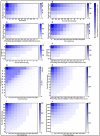Model-Based Evaluation of Transmissibility and Intervention Measures for a COVID-19 Outbreak in Xiamen City, China
- PMID: 35910883
- PMCID: PMC9326243
- DOI: 10.3389/fpubh.2022.887146
Model-Based Evaluation of Transmissibility and Intervention Measures for a COVID-19 Outbreak in Xiamen City, China
Abstract
Background: In September 2021, there was an outbreak of coronavirus disease 2019 (COVID-19) in Xiamen, China. Various non-pharmacological interventions (NPIs) and pharmacological interventions (PIs) have been implemented to prevent and control the spread of the disease. This study aimed to evaluate the effectiveness of various interventions and to identify priorities for the implementation of prevention and control measures.
Methods: The data of patients with COVID-19 were collected from 8 to 30 September 2021. A Susceptible-Exposed-Infectious-Recovered (SEIR) dynamics model was developed to fit the data and simulate the effectiveness of interventions (medical treatment, isolation, social distancing, masking, and vaccination) under different scenarios. The effective reproductive number (Reff ) was used to assess the transmissibility and transmission risk.
Results: A total of 236 cases of COVID-19 were reported in Xiamen. The epidemic curve was divided into three phases (Reff = 6.8, 1.5, and 0). Notably, the cumulative number of cases was reduced by 99.67% due to the preventive and control measures implemented by the local government. In the effective containment stage, the number of cases could be reduced to 115 by intensifying the implementation of interventions. The total number of cases (TN) could be reduced by 29.66-95.34% when patients voluntarily visit fever clinics. When only two or three of these measures are implemented, the simulated TN may be greater than the actual number. As four measures were taken simultaneously, the TN may be <100, which is 57.63% less than the actual number. The simultaneous implementation of five interventions could rapidly control the transmission and reduce the number of cases to fewer than 25.
Conclusion: With the joint efforts of the government and the public, the outbreak was controlled quickly and effectively. Authorities could promptly cut the transmission chain and control the spread of the disease when patients with fever voluntarily went to the hospital. The ultimate effect of controlling the outbreak through only one intervention was not obvious. The combined community control and mask wearing, along with other interventions, could lead to rapid control of the outbreak and ultimately lower the total number of cases. More importantly, this would mitigate the impact of the outbreak on society and socioeconomics.
Keywords: COVID-19; dynamics model; evaluation; intervention; transmissibility.
Copyright © 2022 Liu, Guo, Abudunaibi, Ouyang, Wang, Yang, Deng, Huang, Zhao, Su, Su and Chen.
Conflict of interest statement
The authors declare that the research was conducted in the absence of any commercial or financial relationships that could be construed as a potential conflict of interest.
Figures








Similar articles
-
Effectiveness of a scenario-based, community-based intervention in containing COVID-19 in China.Front Public Health. 2024 Nov 27;12:1449305. doi: 10.3389/fpubh.2024.1449305. eCollection 2024. Front Public Health. 2024. PMID: 39664544 Free PMC article.
-
Evaluating the effectiveness of measures to control the novel coronavirus disease 2019 in Jilin Province, China.BMC Infect Dis. 2021 Mar 6;21(1):245. doi: 10.1186/s12879-021-05936-9. BMC Infect Dis. 2021. PMID: 33676420 Free PMC article.
-
Epidemiological characteristics and transmission dynamics of the outbreak caused by the SARS-CoV-2 Omicron variant in Shanghai, China: a descriptive study.medRxiv [Preprint]. 2022 Jun 18:2022.06.11.22276273. doi: 10.1101/2022.06.11.22276273. medRxiv. 2022. Update in: Lancet Reg Health West Pac. 2022 Dec;29:100592. doi: 10.1016/j.lanwpc.2022.100592. PMID: 35765564 Free PMC article. Updated. Preprint.
-
Community interventions in Low-And Middle-Income Countries to inform COVID-19 control implementation decisions in Kenya: A rapid systematic review.PLoS One. 2020 Dec 8;15(12):e0242403. doi: 10.1371/journal.pone.0242403. eCollection 2020. PLoS One. 2020. PMID: 33290402 Free PMC article.
-
Effective public health measures to mitigate the spread of COVID-19: a systematic review.BMC Public Health. 2021 May 29;21(1):1015. doi: 10.1186/s12889-021-11111-1. BMC Public Health. 2021. PMID: 34051769 Free PMC article.
Cited by
-
Modeling the effects of vaccination, nucleic acid testing, and face mask wearing interventions against COVID-19 in large sports events.Front Public Health. 2022 Nov 9;10:1009152. doi: 10.3389/fpubh.2022.1009152. eCollection 2022. Front Public Health. 2022. PMID: 36438220 Free PMC article.
-
Predicting the transmission dynamics of novel coronavirus infection in Shanxi province after the implementation of the "Class B infectious disease Class B management" policy.Front Public Health. 2023 Dec 22;11:1322430. doi: 10.3389/fpubh.2023.1322430. eCollection 2023. Front Public Health. 2023. PMID: 38186702 Free PMC article.
-
Impact of vaccination and non-pharmacological interventions on COVID-19: a review of simulation modeling studies in Asia.Front Public Health. 2023 Sep 25;11:1252719. doi: 10.3389/fpubh.2023.1252719. eCollection 2023. Front Public Health. 2023. PMID: 37818298 Free PMC article. Review.
-
Epidemiological characteristics and transmission dynamics of the COVID-19 outbreak in Hohhot, China: a time-varying SQEIAHR model analysis.Front Public Health. 2023 Jun 21;11:1175869. doi: 10.3389/fpubh.2023.1175869. eCollection 2023. Front Public Health. 2023. PMID: 37415698 Free PMC article.
-
Impact of different nucleic acid testing scenarios on COVID-19 transmission.Heliyon. 2023 Dec 13;10(1):e23700. doi: 10.1016/j.heliyon.2023.e23700. eCollection 2024 Jan 15. Heliyon. 2023. PMID: 38187298 Free PMC article.
References
Publication types
MeSH terms
LinkOut - more resources
Full Text Sources
Medical
Research Materials

